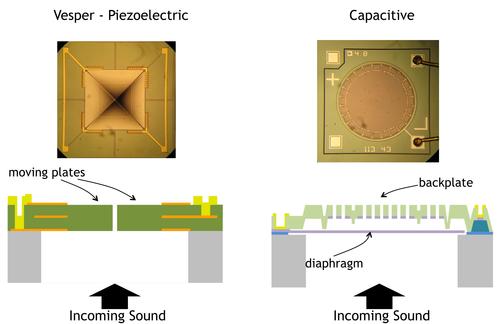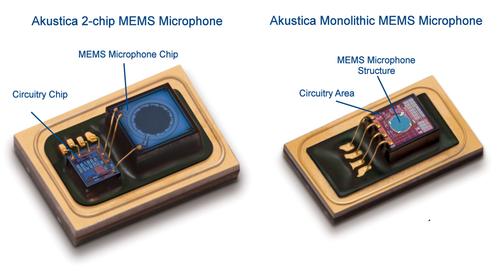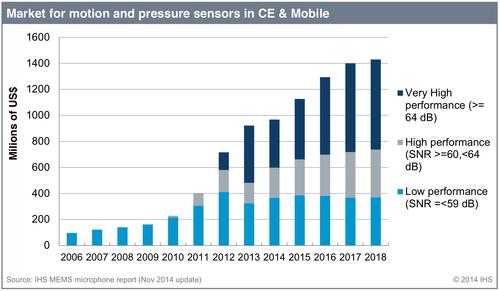Tasks once performed by specialized chips
This article is part of EDN and EE Times' Hot Technologies: Looking ahead to 2015 feature, where our editors examine some of the hot trends and technologies in 2014 that promise to shape technology news in 2015 and beyond.
PORTLAND, Ore. -- Almost every mobile device has ditched its old-fashioned electret microphone invented way back in 1962 at Bell Labs. Most microelectromechanical (MEMS) microphones just copy the basic principle driving electrets, electrically biased diaphragms whose capacitance changes as sound wave vibrate it. On the frontier, however, are piezoelectric MEMS microphones, which promise unheard of signal-to-noise ratios (SNR) of up to 80 dB (versus 65 dB in the best current capacitive microphones) in 2015.
Either way, MEMS microphones are growing like gangbusters, because engineers have found a whole bunch of applications that can use them as a substitute for more specialized sensors starting in 2015 -- getting more bang for the buck (or, if you want to be all official about it, a lower bill of materials).

(Image: Vesper)
The total MEMS market is predicted to top $14 billion in 2015 and $20 billion by 2018, Jean-Christophe Eloy, CEO and president of Yole Development, told the MEMS Executive Congress, the annual meeting of the nonprofit MEMS Industry Group. Jeremie Bouchaud, principal analyst at IHS, said more than $1.4 billion of that will be for MEMS mics.
The biggest reason for the fast growth curve is that smartphone and tablet makers are putting as many as eight MEMS mics into their devices as they discover new ways to use them to eliminate the need for sensors that are often more expensive, such as proximity sensing -- beam forming to zero in on the speaker's location. But one of the most novel new applications is ultrasonic sensing.

MEMS microphones.
(Image: Akustica)
Everyone who has a smartphone or tablet is sick to death of having to clean greasy fingerprints over and over and over again. Wouldn't it be cool if you could engage the icons, buttons, and whatnot while hovering just a few millimeters above the screen? Believe it or not, prototypes are already demonstrating that it is possible by using the MEMS mics that increasingly surround the screen for noise canceling anyway. If those mics are tuned to the ultrasonic range, then ultrasonic emitters will be able to sense the finger just above the screen, thus enabling touchless interaction (and no more cleaning over and over and over). There are dozens of other research projects under way to harness MEMS mics -- which use very little power -- to do tasks that currently require power-hungry dedicated devices, like MEMS gyroscopes.
MEMS mics are already providing increasingly high-definition audio quality for video recordings by canceling out the noise and following the voice of the speaker being filmed (beam forming). HD MEMS mics are also drastically improving the accuracy of voice command functions. In 2015, they should allow devices to mix touch and voice for some functions. There are also burgeoning markets for MEMS mics for Internet of Things devices, medical devices, and wearable electronics of all kinds. Every smart watch has a MEMS mic in it. So do smart glasses like Google Glass, even though the top buyers of MEMS mics remain smartphone and tablet vendors, principally Apple and Samsung.
MEMS mics are studding the insides of the connected automobile to improve voice command accuracy and potentially perform some extra functions that smartphones are experimenting with, such as using ultrasonics to recognize hand gestures.

$1.5 billion by 2018.
(Image: IHS)
MEMS mics are also filling the remaining niches still filled by the venerable electret, such as hearing aids. HD MEMS mics in hearing aids can drastically improve the canceling of ambient noise, improve the sound clarity for easier understanding in conversations, and improve the experience of listening to music. Some even come with Bluetooth connections to your iPhone. In fact, Invensense Inc., which bought Analog Devices' MEMS mic business this year, has formed a strategic alliance with Sonion A/S giving it exclusive rights to market its MEMS mics to the hearing aid market.


英伟达被立案调查引发全球热议:传递中国将毫不犹豫反制信号?


 专利申请
专利申请
 知识产权质押融资
知识产权质押融资
 专利地图分析
专利地图分析
 版权登记
版权登记
 集成电路布图设计
集成电路布图设计
 商标交易
商标交易
 商标申请
商标申请
 专利交易
专利交易
 专利无效
专利无效



热门评论